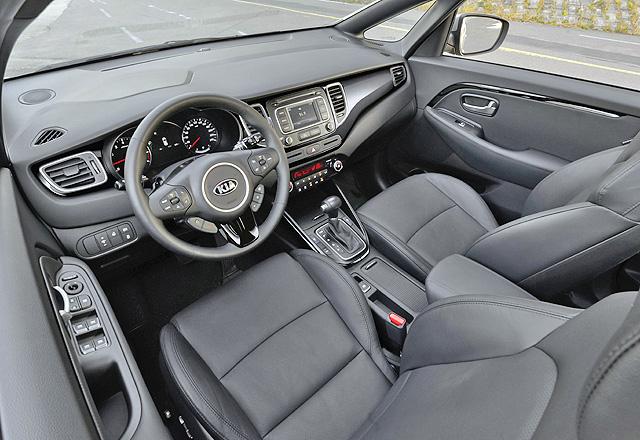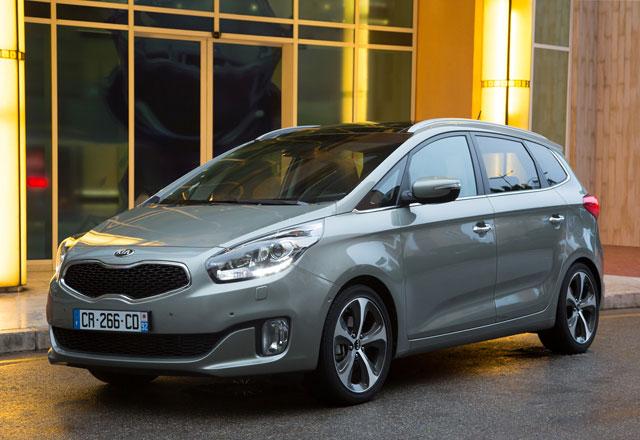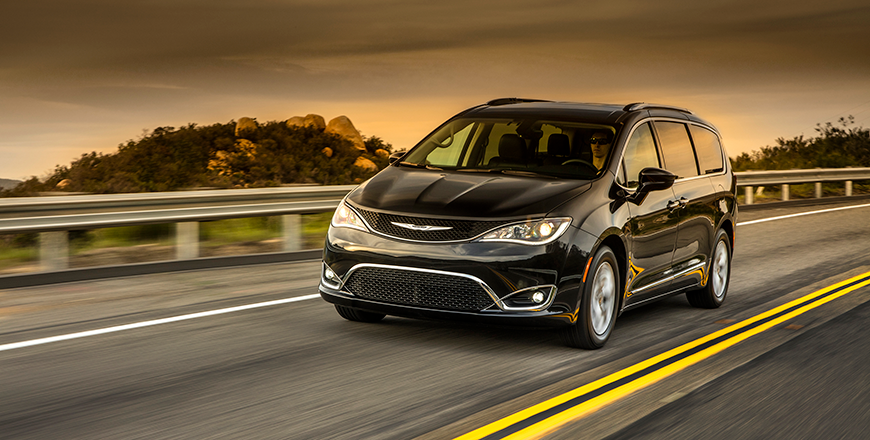You are here
Sensible seven-seater
By Ghaith Madadha - Feb 24,2014 - Last updated at Feb 24,2014

Launched last year, the third generation Kia Carens is a compact- to mid-size multi-purpose vehicle (MPV) with a more stylish European-influenced design. In addition to sharper lines and aesthetics, the new Carens’ form is more similar to an overgrown hatchback than a saloon-based MPV or re-modded van. Better to drive than before, the new Carens is also better packaged and space efficient, with versatile seating and optional seven-seat format. Offered in three engine options including 1.5 and 2.0 petrol engines, the Carens’ best engine option was however the European market 1.7-litre CRDi turbo-diesel engine, with six-speed manual, rather than automatic transmission.
The case for diesel
Well-kitted, even basic trim Carens feature MDPS electric steering with adjustable levels of resistance, remote central locking, adjustable steering wheel, front seatback pockets, AC, CD player with MP3, USB and Bluetooth compatibility, rain-sensing wipers, rear view camera, front and curtain airbags and electronic driver aids including stability and traction control, hill-start and brake-force assist systems. Middle row seats get three-point side seatbelts but a two-point belt for the middle passenger. Range-topping EX spec includes side mirrors indicator lights, Xenon headlamps, LED running and rear lights, rear-side window blinds, 10-way adjustable driver’s seat, child monitoring cabin mirror, leather upholstery and front parking sensors.
Quicker, more efficient and often cleaner than petrol versions of same models, modern turbo-diesel cars like the Carens 1.7 CRDi also deliver more generous mid-range torque, which is particularly suitable for multi-passenger MPVs and is more useful for daily driving, commuting and hilly terrain like Jordan’s. Offering similar efficiency as hybrids without the extra weight, complication and cost, turbo-diesels outsell petrol cars in Europe, and one wishes that “clean” low-sulfur diesel becomes available to Jordanian motorists, so that diesel passenger cars might become legal. If they were to be legalised, one feels they should benefit from similar import duty incentives as hybrids.
Well-packaged
A more purposeful and dynamic looking car than the one it replaces, the new Carens is more tightly penned and packaged, starting with its new chrome outline and honeycomb “tiger grille” corporate face, more bulging and complex bonnet landscaping. Smart big alloy wheels, low side skirts and black lower rear bumper cladding add a hint of sporting flavor that is reflected by the tailgate spoiler at the end of its flowing roofline arc. Lending presence, the Carens’ high flanks are visually broken to avoid a slab-sided look by a sharp crease below the waistline, and subtle lower flank moldings.
Restrained and tastefully styled and appointed, the new Carens has a European sensibility, including sparing use of chrome details and the absence of faux wood, and instead uses piano black dashboard panels mixed with strategically placed soft textures and some less prominently placed hard plastics. Sensible and business-like inside, the Carens’ thick contoured steering wheel falls nicely to hand, while build quality seems good and function, button and instrument layouts and ergonomics are user-friendly. Dark interior colours look best, while an optional panoramic sunroof gives an airier ambiance without restricting first and second row headspace owing to the Carens’ high roof.
Practical and economic
Practical, versatile and compact, the Carens seats seven with optional 50:50 split folding third row seating. Lower, shorter and narrower than before, the Carens’ 50mm longer wheelbase however provides excellent front and second row head and leg space. Third row space is convenient for shorter passengers or children. Second row 60:40 split folding seats slide and tilt to manage space between rearmost rows. Minimum window-line cargo capacity is 103-litres behind the third row, expanding to 492-litres and 1667-litres behind second and first rows, in addition to an under-boot storage compartment. The front passenger seat also folds flat to increase capacity.
Powered by a modern 1.7-litre common-rail turbo-diesel for-cylinder engine, the Carens 1.7CRDi develops 134BHP at 4,000rpm and a massive 243lb/ft torque throughout 1,750-2,500rpm, and returns frugal 5.4l/100km derv-drinking and low 144g/km carbon dioxide emissions on the combined cycle. With little diesel clatter audible at idle, the Carens CRDi feels refined and smooth in delivery once turbos are spooled. A six-speed manual gearbox slips easily into gear and its clutch pedal is light and biting-point intuitive, and can better control the turbo-diesel engine to avoid low-rev turbo lag and better exploit its rich and muscular but slightly narrow mid-range torque band.
Compact and comfortable
With shorter final drive gearing for first and second gear helping the turbo-diesel spool up quicker, the Carens CRDi achieve a 10.4-second 0-100km/h time and once into its high torque mid-range sweet spot, pulls indefatigably up inclines and when overtaking on highways, and can reach 191km/h. Low-revving, the CRDi builds up to maximum power quickly, by when one shift up and back into its rich mid-range. Stable and refined on highways, where it is most economic, the Carens CRDi is a good long-distance cruiser, while its compact and well-packaged dimensions make it easy to maneuver and park in tight urban settings.
Driven on narrow and winding Monte Carlo roads, the Carens was agile, maneuverable and slipped through snaking lanes and often congested roads well. While front visibility is good, thick rakish front pillars slightly affect front-side views close to the kerb, but small front quarter windows help. A comfortable and supple ride, the Carens well-absorbs bumps and cracks. Steering is light, quick and accurate but reassuring at speed. Turn-in is tidy, even with the heavier turbo-diesel engine, and while some body lean is evident through corners, the Carens feels composed, and lighter and more nimble than expected considering its 1,522kg weight.
|
SPECIFICATIONS Engine: 1.7-litre, common-rail turbo-diesel, transverse 4-cylinders Bore x stroke: 77.2 x 90mm Compression ratio: 17:1 Valve-train: 16-valve, DOHC, continuously variable valve timing Gearbox: 6-speed manual, front-wheel-drive Ratios: 1st 3.615; 2nd 1.794; 3rd 1.542; 4th 1.176; 5th 0.974; 6th 0.829; R 3.731 Final drive 1-2 / 3-6 ratios: / 4.063 / 2.955 Power, BHP (PS) [kW]: 134 (136) [100] @ 4,000rpm Power-to-weight: 88BHP/ton Torque, lb/ft (Nm): 243 (330) @ 1,750-2,500rpm Torque-to-weight: 216.8Nm/ton 0-100km/h: approximately 10.4-seconds Top speed: 191km/h Fuel efficiency, combined: 5.4l/100km CO2 emissions, combined: 144g/km Length: 4,525mm Width: 1,805mm Height: 1,610mm Wheelbase: 2,750mm Track, F/R: 1,573 / 1,586mm Overhang, F/R: 940 / 835mm Ground clearance: 151mm Aerodynamic drag co-efficient: 0.30 Headroom, F/M/R: 1,035 / 1,002 / 867mm Legroom, F/M/R: 1,034 / 940 / 707mm Shoulder-room, F/M/R: 1,438 / 1,440 / 1,313mm Luggage volume, behind third / second / first rows: 103 / 492 / 1,667-litres Fuel capacity: 58-litres Kerb weight: 1,522kg Steering: Electric-assisted rack & pinion Lock-to-lock: 2.7-turns Turning Circle: 11-meters Suspension, F: MacPherson struts, coil springs gas-charged dampers, stabiliser bar Suspension, R: Torsion beam, coil springs, gas-charged dampers Brakes, F/R: 300 x 28mm ventilated disc / 284 x 10mm disc Tyres: 225/45R17 |
Related Articles
A handsome, practical and compact car-like multi-purpose vehicle (MPV) of the sort that one would expect to be far more popular in a market
Enormously spacious and large, yet, manoeuvrable and economic — and bearing Jordanians’ most coveted automotive brand — it was only a matter
The headlining brand of the US wing of the Italian-American Fiat Chrysler Group (FCA) and one of Detroit’s traditional ‘big three’, Chrysler



















